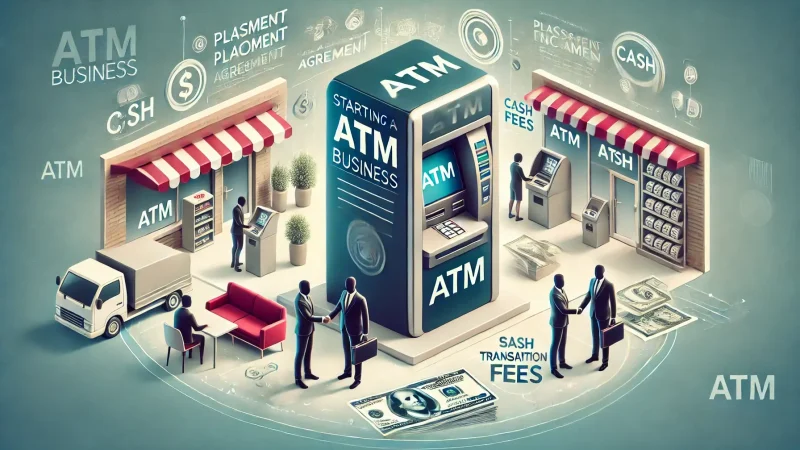ATM Machine Business Profits: How to Maximize Earnings

Starting an ATM machine business can be a lucrative venture with relatively low overhead and high-profit potential. The primary source of revenue comes from the surcharge fees charged to users each time they withdraw cash. Understanding how to optimize locations, manage cash flow, and maintain your machines will significantly impact your profits. In this article, we’ll explore how ATM machine business profits are generated and strategies to maximize them.
How Profits are Generated from ATM Machines
The main revenue stream for an ATM business comes from the surcharge fees users pay to withdraw money. These fees typically range between $2 to $3 per transaction, though they can vary based on location and demand. Here’s a breakdown of the key factors that contribute to ATM business profits:
Transaction Volume:
The number of transactions processed by an ATM is directly linked to your profits. Locations with high foot traffic, such as busy retail areas, convenience stores, or entertainment venues, tend to generate more transactions, leading to higher profits. On average, an ATM in a high-traffic area can perform anywhere from 100 to 300 transactions per month.
Surcharge Fees:
ATM business owners have the flexibility to set surcharge fees based on the demand and type of location. While the average surcharge is around $2.50, some locations may charge higher fees, particularly if there’s a lack of competing ATMs in the area.
Revenue Splits:
When placing ATMs in businesses you don’t own, you’ll often enter into an agreement where a portion of the surcharge fee is shared with the business owner. Typically, you can negotiate to keep 60-80% of the surcharge, with the remaining amount going to the business hosting the ATM. This revenue-sharing model encourages business owners to allow ATMs on their premises, as they benefit from a passive income stream.
Key Factors Influencing ATM Business Profits
Location:
Location is the most crucial factor in determining ATM profitability. ATMs placed in high-traffic areas, such as shopping malls, nightclubs, and gas stations, generate more transactions, increasing overall revenue. In contrast, ATMs in low-traffic areas may not perform as well, leading to lower profits.
Maintenance and Cash Management:
ATM machines require regular maintenance and cash replenishment. Profits can decrease if machines frequently run out of cash or experience downtime. To maximize profits, ensure your machines are well-maintained and that cash levels are consistently replenished.
Upfront Costs and Ongoing Expenses:
Initial investments for starting an ATM business include purchasing or leasing ATM machines, software setup, and installation fees. Purchasing an ATM costs between $2,000 to $6,000, while leasing options are also available. Ongoing expenses such as cash replenishment, software updates, and maintenance will affect your overall profit margins.
ATM Network Fees:
ATMs must be connected to a processing network to facilitate transactions. There are small network fees associated with each transaction, usually less than $1. Although these fees are minor, they can add up over time and impact profits.
How to Maximize ATM Business Profits
Choose High-Traffic Locations:
Place your ATMs in busy areas where people are likely to need cash frequently. Ideal locations include convenience stores, event venues, bars, and high-traffic retail spots. High foot traffic directly correlates with transaction volume, driving higher profits.
Negotiate Favorable Revenue Shares:
When negotiating placement agreements with business owners, aim to keep a higher percentage of the surcharge fees. Offering 20-30% of the revenue to the business while keeping the remainder can maximize your earnings.
Optimize Surcharge Fees:
Set competitive yet profitable surcharge fees. In locations with few ATM options, you can charge higher fees without discouraging usage. However, ensure that your fees remain reasonable to avoid losing customers to nearby ATMs with lower charges.
Expand to Multiple Locations:
Once you’ve established one successful ATM location, reinvest your profits to expand to additional locations. The more machines you operate, the higher your overall profits will be.
Monitor and Maintain Your Machines:
Regular maintenance ensures that your ATMs stay operational, minimizing downtime. You should also monitor cash levels to avoid running out of funds, which could lead to missed revenue opportunities.
Utilize Data Analytics: Use ATM software to track transaction data and cash flow. This data can help you identify the busiest times and adjust cash replenishment schedules accordingly. By efficiently managing cash, you reduce the risk of downtime, improving profits.
Conclusion
ATM machine business profits largely depend on strategic placement, effective cash management, and optimizing surcharge fees. By choosing high-traffic locations, negotiating favorable revenue splits, and expanding your network of machines, you can maximize your earnings. With low maintenance requirements and the potential for passive income, an ATM business is a scalable and profitable venture for entrepreneurs looking to generate consistent returns.






